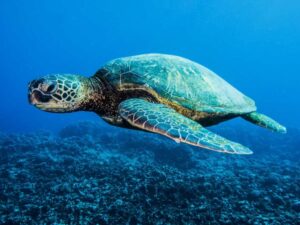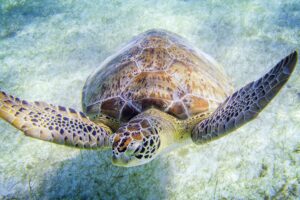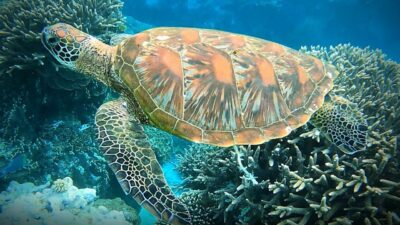Have you ever wondered about the incredible abilities of sea turtles? They glide through the ocean with such ease, but have you ever thought about how long they can hold their breath underwater?
On average, they can stay submerged for about 4 to 7 minutes. However, during intense activity like feeding or evading predators, they may surface more frequently to replenish their oxygen supply.
This ability to endure extended periods underwater allows them to navigate the depths of the ocean with remarkable efficiency, contributing to their survival in their marine habitat.
Physiology of Green Sea Turtles

Green sea turtles, known scientifically as Chelonia mydas, are fascinating creatures with unique physiological adaptations that enable them to thrive in their marine environment. Here’s an overview of their physiology:
- Shell: The green sea turtle’s most distinctive feature is its shell, which is composed of two parts: the carapace (upper shell) and the plastron (lower shell). These shells are made of bony plates covered by a layer of keratin.
- Respiration: Green sea turtles are reptiles, so they breathe air using lungs. However, they can stay underwater for extended periods thanks to their ability to slow their heart rate, allowing them to conserve oxygen. When they surface, they quickly replenish their oxygen supply.
- Salt Glands: Like other marine reptiles, green sea turtles have salt glands near their eyes that allow them to excrete excess salt accumulated from drinking seawater. This adaptation helps them maintain proper salt balance in their bodies.
- Feeding Adaptations: Green sea turtles are primarily herbivores, feeding on seagrasses and algae. Their jaws are serrated, which helps them tear vegetation, and their digestive system is designed to process plant matter efficiently.
- Thermoregulation: Green sea turtles are ectothermic, meaning they rely on external sources of heat to regulate their body temperature. They bask in the sun to warm up and may migrate to warmer waters to avoid cold temperatures.
- Reproduction: Female green sea turtles return to beaches to lay their eggs, a process known as nesting. They dig nests in the sand and deposit dozens of eggs, which incubate for around two months before hatching. The temperature of the nest determines the sex of the hatchlings, with warmer temperatures producing more females and cooler temperatures producing more males.
- Longevity: Green sea turtles are known for their long lifespan, with some individuals living for several decades. Their exact lifespan is difficult to determine in the wild, but they are known to reach sexual maturity around 20-50 years of age.
These physiological adaptations help green sea turtles thrive in their marine habitat, but they also face numerous threats, including habitat loss, pollution, and hunting. Conservation efforts are crucial for ensuring the survival of these magnificent creatures.
Respiratory system of green sea turtles
The respiratory system of green sea turtles, like other reptiles, is adapted for breathing air. Here’s an overview of their respiratory system:
- Lungs: Green sea turtles have well-developed lungs that allow them to extract oxygen from the air. When they surface to breathe, they fill their lungs with air through their nostrils.
- Nostrils: Green sea turtles have two nostrils located on the top of their heads. They use these nostrils to breathe when they surface, but they can also close them tightly to prevent water from entering their respiratory system while underwater.
- Trachea: After air enters through the nostrils, it passes through the trachea, also known as the windpipe. The trachea is a tube-like structure that conducts air from the nostrils to the lungs.
- Bronchi and Bronchioles: Inside the lungs, the trachea branches into smaller tubes called bronchi, which further divide into even smaller tubes called bronchioles. These structures distribute air throughout the lungs and facilitate gas exchange.
- Gas Exchange: In the lungs, oxygen from the air diffuses across the walls of the bronchioles and into the bloodstream, while carbon dioxide diffuses from the bloodstream into the air in the lungs. This process, known as gas exchange, allows green sea turtles to obtain oxygen for cellular respiration and remove carbon dioxide, a waste product of metabolism.
- Respiratory Movements: Green sea turtles use a combination of buccal pumping and tidal breathing to ventilate their lungs. During buccal pumping, they alternately expand and contract the muscles of their throat to move air in and out of their lungs. Tidal breathing involves passive inhalation and exhalation driven by changes in pressure within the respiratory system.
Overall, the respiratory system of green sea turtles enables them to efficiently extract oxygen from the air and survive in their marine environment, where they spend most of their lives submerged but regularly come to the surface to breathe.
How long can a green sea turtle hold its breath?

Green sea turtles are impressive divers, capable of holding their breath for extended periods while underwater. On average, they can remain submerged for around 4 to 5 minutes during routine dives. However, they have been known to stay underwater for much longer periods, sometimes up to 30 minutes or more, especially when resting or sleeping.
Several physiological adaptations contribute to their ability to hold their breath for extended periods:
- Slow Metabolism: Green sea turtles have a relatively slow metabolic rate compared to mammals. This means they consume oxygen at a slower rate, allowing them to conserve oxygen during dives.
- Large Lung Capacity: Green sea turtles have large lungs relative to their body size, which enables them to store more oxygen during each breath.
- Efficient Oxygen Utilization: Green sea turtles are efficient at using the oxygen stored in their lungs and bloodstream. They can tolerate low levels of oxygen in their tissues, allowing them to prolong their dives without experiencing oxygen deprivation.
- Bradycardia: Green sea turtles exhibit bradycardia, a slowing of the heart rate, when submerged. By reducing their heart rate, they reduce their oxygen consumption, further extending their dive time.
- Anaerobic Metabolism: During prolonged dives, green sea turtles can switch to anaerobic metabolism, which doesn’t require oxygen. While anaerobic metabolism produces less energy than aerobic metabolism and can lead to the buildup of lactic acid, it allows green sea turtles to continue functioning even when oxygen levels are low.
- Behavioral Adaptations: Green sea turtles exhibit specific behaviors to optimize their dive times. For example, they may rest or sleep on the seafloor, where they expend less energy and can conserve oxygen. Additionally, they may adjust their swimming speed and depth to minimize oxygen consumption.
Overall, the combination of physiological and behavioral adaptations enables green sea turtles to hold their breath for remarkable lengths of time, allowing them to forage, rest, and navigate their marine environment effectively. However, they still need to surface periodically to replenish their oxygen supply and remove accumulated carbon dioxide.
Factors influencing green sea turtle breath-holding capabilities
Several factors influence the breath-holding capabilities of green sea turtles, determining how long they can remain submerged before needing to surface for air. These factors include:
- Size and Age: Larger green sea turtles generally have larger lung capacities and can hold their breath for longer periods compared to smaller individuals. Additionally, as turtles grow and mature, their physiological adaptations for diving become more efficient, allowing them to prolong their dive times.
- Activity Level: The activity level of green sea turtles influences their oxygen consumption and, consequently, their breath-holding capabilities. Turtles that are actively swimming, foraging, or evading predators may have shorter dive times compared to turtles that are resting or sleeping on the seafloor.
- Water Temperature: Water temperature affects the metabolic rate of green sea turtles. Warmer water temperatures generally increase metabolic activity, leading to higher oxygen consumption and shorter dive times. Conversely, in colder water, turtles may have a lower metabolic rate and be able to hold their breath for longer periods.
- Dive Depth: The depth of the dive can influence the amount of pressure experienced by the turtle’s body, which affects oxygen consumption. Deeper dives require more energy to counteract the increased pressure, potentially leading to shorter dive times.
- Physiological Condition: The overall health and physiological condition of a green sea turtle can impact its breath-holding capabilities. Turtles that are injured, stressed, or experiencing health issues may have reduced diving abilities compared to healthy individuals.
- Environmental Conditions: Environmental factors such as water clarity, turbulence, and prey availability can influence the behavior and activity level of green sea turtles, which in turn affects their dive durations.
- Previous Diving Experience: Green sea turtles can learn and adapt their diving behavior based on past experiences. Individuals that have had successful foraging dives in specific areas may exhibit longer dive times in those locations in the future.
- Seasonal and Circadian Rhythms: Seasonal changes and daily circadian rhythms may also impact the diving behavior of green sea turtles. For example, turtles may alter their dive patterns in response to changes in daylight, temperature, or food availability.
Understanding these factors is essential for researchers and conservationists studying green sea turtles’ diving behavior and habitat requirements. By identifying the key factors influencing breath-holding capabilities, efforts can be made to protect critical habitats and mitigate threats to these endangered marine reptiles.
Factors Affecting Breath Holding

The ability to hold one’s breath underwater, known as apnea, is influenced by various physiological, environmental, and behavioral factors. While the specifics can vary among species, here are the key factors affecting breath-holding capabilities in general:
- Lung Capacity: The size of the lungs determines the amount of air that can be stored and utilized during a breath-hold. Individuals with larger lung capacities typically have the potential for longer apnea durations.
- Oxygen Stores: Oxygen reserves in the bloodstream and tissues play a crucial role in determining how long someone can hold their breath. Factors such as hemoglobin levels and the efficiency of oxygen extraction by tissues influence these reserves.
- Metabolic Rate: Metabolism affects oxygen consumption rates. Individuals with lower metabolic rates typically use oxygen more slowly, allowing for longer apnea durations. Conversely, high metabolic rates increase oxygen demand, leading to shorter breath-holding times.
- Fitness Level: Physical fitness and conditioning can enhance breath-holding capabilities. Regular training, especially specific breath-holding exercises, can improve lung function, oxygen utilization, and tolerance to elevated carbon dioxide levels.
- Respiratory Adaptations: Certain physiological adaptations, such as the mammalian diving reflex, can extend breath-holding times. This reflex triggers a series of responses, including bradycardia (slowing of the heart rate), peripheral vasoconstriction (reduced blood flow to non-essential organs), and spleen contraction (releasing additional red blood cells), all of which conserve oxygen and prolong apnea.
- CO2 Tolerance: Carbon dioxide (CO2) buildup is a primary trigger for the urge to breathe. Individuals with higher tolerance levels for elevated CO2 concentrations can withstand longer breath-holding periods before experiencing discomfort and the reflex to breathe.
- Water Temperature: Cold water can slow metabolic rates and reduce oxygen consumption, potentially extending breath-holding capabilities. However, cold water can also induce involuntary gasping and increase the risk of hypothermia, affecting apnea duration.
- Dive Depth: Pressure changes with depth affect gas exchange and the distribution of gases in the body. Shallow dives may allow for longer breath-holding times due to lower pressure-related oxygen consumption, whereas deeper dives require greater oxygen reserves and may shorten apnea durations.
- Experience and Training: Experience and training can improve breath-holding techniques, breath control, and relaxation, all of which contribute to extending apnea durations. Experienced free divers, for example, often develop specialized breathing techniques and mental strategies to optimize breath-holding performance.
By understanding and optimizing these factors, individuals can improve their breath-holding capabilities, whether for recreational activities like swimming or diving or for specialized professions such as freediving or underwater photography. However, it’s essential to prioritize safety and never push breath-holding limits beyond personal capabilities.
Conclusion
How long can a green sea turtle hold its breath? In conclusion, the green sea turtle possesses remarkable breath-holding capabilities, allowing it to navigate its marine habitat with impressive efficiency.
Factors such as its physiological adaptations, including lung capacity and metabolic rate, alongside behavioral strategies like resting on the seafloor, contribute to its ability to hold its breath. With dive durations averaging around 4 to 5 minutes and sometimes extending beyond 30 minutes, the green sea turtle exemplifies nature’s ingenuity in adapting to life underwater.

